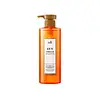What's inside
What's inside
 Key Ingredients
Key Ingredients

No key ingredients
 Benefits
Benefits

 Concerns
Concerns

 Ingredients Side-by-side
Ingredients Side-by-side

Water
Skin ConditioningCaprylyl/Capryl Glucoside
CleansingSodium Methyl Cocoyl Taurate
CleansingSodium Lauroyl Sarcosinate
CleansingDecyl Glucoside
CleansingCocamidopropyl Betaine
CleansingDisodium Cocoamphodiacetate
CleansingPolyquaternium-10
Polyquaternium-73
Panthenol
Skin ConditioningVinegar
Urtica Dioica Extract
AstringentPalmaria Palmata Extract
Skin ProtectingPrunus Amygdalus Dulcis Oil
Skin ConditioningArgania Spinosa Kernel Oil
EmollientSodium Benzoate
MaskingPotassium Sorbate
PreservativePEG-150 Distearate
EmulsifyingCI 15985
Cosmetic ColorantWater, Caprylyl/Capryl Glucoside, Sodium Methyl Cocoyl Taurate, Sodium Lauroyl Sarcosinate, Decyl Glucoside, Cocamidopropyl Betaine, Disodium Cocoamphodiacetate, Polyquaternium-10, Polyquaternium-73, Panthenol, Vinegar, Urtica Dioica Extract, Palmaria Palmata Extract, Prunus Amygdalus Dulcis Oil, Argania Spinosa Kernel Oil, Sodium Benzoate, Potassium Sorbate, PEG-150 Distearate, CI 15985
Water
Skin ConditioningSodium C14-16 Olefin Sulfonate
CleansingCocamidopropyl Betaine
CleansingGlycerin
HumectantPyrus Malus Fruit Extract
Skin ConditioningVinegar
Decyl Glucoside
CleansingVitis Vinifera Fruit Extract
Skin ConditioningRoyal Jelly Extract
Skin ConditioningPersea Gratissima Fruit Extract
EmollientHippophae Rhamnoides Fruit Extract
Skin ConditioningSaccharum Officinarum Extract
MoisturisingMelaleuca Alternifolia Leaf Extract
PerfumingOlea Europaea Fruit Extract
BleachingDaucus Carota Sativa Root Extract
Skin ConditioningPrunus Mume Fruit Extract
HumectantRubus Chamaemorus Fruit Extract
AntioxidantHibiscus Sabdariffa Flower Extract
Skin ConditioningLuffa Cylindrica Fruit Extract
Skin ConditioningActinidia Chinensis Fruit Extract
EmollientCitrus Limon Fruit Extract
MaskingAdansonia Digitata Seed Extract
Skin Conditioning1,2-Hexanediol
Skin ConditioningCaprylhydroxamic Acid
Ethylhexylglycerin
Skin ConditioningMethylpropanediol
SolventSodium Chloride
MaskingPolyquaternium-10
Allantoin
Skin ConditioningGuar Hydroxypropyltrimonium Chloride
Skin ConditioningDisodium EDTA
Cocamide Mea
EmulsifyingCynanchum Atratum Extract
Skin ConditioningCitric Acid
BufferingParfum
MaskingWater, Sodium C14-16 Olefin Sulfonate, Cocamidopropyl Betaine, Glycerin, Pyrus Malus Fruit Extract, Vinegar, Decyl Glucoside, Vitis Vinifera Fruit Extract, Royal Jelly Extract, Persea Gratissima Fruit Extract, Hippophae Rhamnoides Fruit Extract, Saccharum Officinarum Extract, Melaleuca Alternifolia Leaf Extract, Olea Europaea Fruit Extract, Daucus Carota Sativa Root Extract, Prunus Mume Fruit Extract, Rubus Chamaemorus Fruit Extract, Hibiscus Sabdariffa Flower Extract, Luffa Cylindrica Fruit Extract, Actinidia Chinensis Fruit Extract, Citrus Limon Fruit Extract, Adansonia Digitata Seed Extract, 1,2-Hexanediol, Caprylhydroxamic Acid, Ethylhexylglycerin, Methylpropanediol, Sodium Chloride, Polyquaternium-10, Allantoin, Guar Hydroxypropyltrimonium Chloride, Disodium EDTA, Cocamide Mea, Cynanchum Atratum Extract, Citric Acid, Parfum
Ingredients Explained
These ingredients are found in both products.
Ingredients higher up in an ingredient list are typically present in a larger amount.
Cocamidopropyl Betaine is a fatty acid created by mixing similar compounds in coconut oil and dimethylaminopropylamine, a compound with two amino groups.
This ingredient is a surfactant and cleanser. It helps gather the dirt, pollutants, and other impurities in your skin to be washed away. It also helps thicken a product and make the texture more creamy.
Being created from coconut oil means Cocamidopropyl Betaine is hydrating for the skin.
While Cocamidopropyl Betaine was believed to be an allergen, a study from 2012 disproved this. It found two compounds in unpure Cocamidopropyl Betaine to be the irritants: aminoamide and 3-dimethylaminopropylamine. High-grade and pure Cocamidopropyl Betaine did not induce allergic reactions during this study.
Learn more about Cocamidopropyl BetaineDecyl Glucoside is a glucose-based surfactant and emulsion stabilizer. It is created by reacting glucose with the fatty acids from plants.
Surfactants help clean the skin by trapping oil, sebum, and dirt to be washed away. As an emulsion stabilizer, it stabilizes the ingredients in a product by preventing them from separating.
This ingredient is biodegradable and non-toxic. This ingredient is commonly found in baby shampoos.
Decyl Glucoside is sometimes used to stabilize the UV filter Tinosorb.
Learn more about Decyl GlucosidePolyquaternium-10 is an ammonium salt of hydroxyethylcellulose. It is a white and granular powder used as a film-former and anti-static agent.
This ingredient is commonly found in hair conditioning products. According to a manufacturer, its positive charge makes it great for absorbing hair proteins. The manufacturer also states this ingredient helps with curl retention.
For haircare friends: this ingredient is not a silicone.
Learn more about Polyquaternium-10In cosmetics, vinegar is often used to help adjust the pH of a product. It is also a light exfoliant. The pH of your skin is important to maintain a healthy skin barrier.
Vinegar is created by the process of double-fermentation. It is an aqueous solution consisting mostly of water and acetic acid. Typically, vinegar contains anywhere from 5-8% acetic acid.
Other components include small amounts of contains small amounts of tartaric acid and citric acid. Depending on what is used to ferment the vinegar, it can have traces of flavoring as well.
Learn more about VinegarWater. It's the most common cosmetic ingredient of all. You'll usually see it at the top of ingredient lists, meaning that it makes up the largest part of the product.
So why is it so popular? Water most often acts as a solvent - this means that it helps dissolve other ingredients into the formulation.
You'll also recognize water as that liquid we all need to stay alive. If you see this, drink a glass of water. Stay hydrated!
Learn more about Water